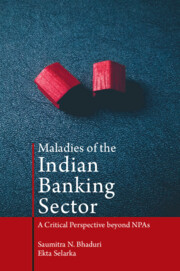Book contents
- Frontmatter
- Dedication
- Contents
- List of Figures
- List of Tables
- Foreword
- Acknowledgements
- 1 Prologue
- 2 The Indian Banking Sector: A Brief History
- 3 The Index of Credit Allocative Efficiency
- 4 Macroeconomic Analyses of Bank Credit Misallocation in the Indian Corporate Sector: Investigation of Pro-cyclicality
- 5 Determinants of Bank Credit Misallocation: Firm-level Analysis
- 6 Allocative Efficiency of Bank Credit and Firm Performance
- 7 Credit Reallocation by Indian Banks in the Aftermath of the Global Financial Crisis
- 8 The Zombie Story: Credit Boom and the Rise of Zombie Firms in the Indian Economy
- 9 Epilogue
- Bibliography
- Index
8 - The Zombie Story: Credit Boom and the Rise of Zombie Firms in the Indian Economy
Published online by Cambridge University Press: 27 September 2022
- Frontmatter
- Dedication
- Contents
- List of Figures
- List of Tables
- Foreword
- Acknowledgements
- 1 Prologue
- 2 The Indian Banking Sector: A Brief History
- 3 The Index of Credit Allocative Efficiency
- 4 Macroeconomic Analyses of Bank Credit Misallocation in the Indian Corporate Sector: Investigation of Pro-cyclicality
- 5 Determinants of Bank Credit Misallocation: Firm-level Analysis
- 6 Allocative Efficiency of Bank Credit and Firm Performance
- 7 Credit Reallocation by Indian Banks in the Aftermath of the Global Financial Crisis
- 8 The Zombie Story: Credit Boom and the Rise of Zombie Firms in the Indian Economy
- 9 Epilogue
- Bibliography
- Index
Summary
Introduction
This chapter explores the extent to which the pro-cyclic credit bubble in the early 2000s led to the misallocation through the extension of bank credit towards firms that are less likely to cover future debt servicing costs. Such a practice of extending loans to non-viable borrowers is known as ‘zombie lending’ or ‘evergreening’. Using a sample of 7,871 firm observations for the period of 1990–2017, we try to address three important questions: first, using a long time-series data spanning across multiple business cycles, we try to trace the rise in the incidence of zombie lending in India. Notably, we ask whether the recent spurt in zombie lending (after 2010) can be attributed to significant credit booms and a financial disruption, or they mirror a more general business cycle trend. Second, using a heterogeneous sample of firms cutting across many industries, we try to find what types of firms have attracted more zombie lending than others. Finally, we explore the causes of the rise of zombie lending, particularly in the post-crisis period. Specifically, we try to relate to the strand of literature that suggests that weak banks tend to roll over loans to non-viable firms to avoid declaring them as NPAs (Storz et al., 2017; Schivardi, Sette, and Tabellini, 2017). We further this literature by exploiting a natural opportunity in India by examining whether the pro-cyclic credit bubble in the pre-crisis period coupled with the economic slowdown as an aftermath of the global financial crisis (GFC) led to a rise in the incidence of zombie lending.
Zombie lending and the consequent window-dressing of the banks’ balance sheet to manage the extent of non-performing assets (NPAs) on their book have recently gained increasing attention amongst academics and regulators. There is a widespread perception in the policy circle that politicization and weak organizations impede the process of creative destruction, which further increases the chances of misallocation (Caballero and Hammour, 2001). With persistent misallocation, banks tend to undercapitalize and fail to support healthy credit growth in the economy. While focusing primarily on survival, these banks foster an environment suitable for unprofitable, or ‘zombie’ lending (Tan, Huang, and Woo, 2016).
- Type
- Chapter
- Information
- Maladies of the Indian Banking SectorA Critical Perspective beyond NPAs, pp. 160 - 183Publisher: Cambridge University PressPrint publication year: 2022
- 1
- Cited by



